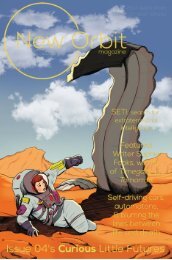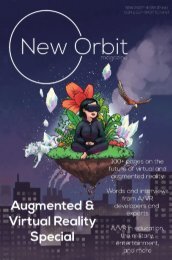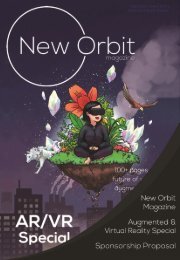Feb 2018 v01 online
((Incomplete formatting))
((Incomplete formatting))
You also want an ePaper? Increase the reach of your titles
YUMPU automatically turns print PDFs into web optimized ePapers that Google loves.
eyond just cost. The flexibility and even<br />
customisability of VR means that soldiers<br />
are able to train in virtual environments<br />
simulating the chaos of an active field in a<br />
way that was previously not possible.<br />
Taking this customisability to its full<br />
extent, under VR it is possible that new,<br />
undeployed soldiers could walk the streets<br />
of a town they will soon be deployed in by<br />
way of a VR headset. This recruit could<br />
then explore this foreign location, getting<br />
to know the routes, roads, infrastructure,<br />
and shortcuts until they could recall the<br />
entire layout by memory, and be able to<br />
navigate the area purely on instinct. The<br />
only better way to familiarise themselves in<br />
this way would be to be at the actual site<br />
itself, but by using VR, they would lose the<br />
extra flight costs and the risk of getting shot<br />
at.<br />
The value of understanding the layout of<br />
an area intimately well as a soldier is<br />
obvious. Rather than having to rely on<br />
maps and other navigational devices to<br />
traverse a town or village, deployed<br />
personnel could move around a<br />
deployment site off their own knowledge as<br />
confidently as if they were traversing their<br />
own back yard. Vehicle drivers would be<br />
able to spend large amounts of time<br />
familiarising themselves with transport<br />
routes and the possible dangers associated<br />
with certain areas before they themselves<br />
are in harm’s way. When it came to<br />
transporting troops, weapons, supplies, or<br />
other precious cargo through a live<br />
battlefield, the fact that they would be able<br />
to drive purely off instinct and memory<br />
would mean that they could react promptly<br />
and effectively to threats under times of<br />
duress, possibly saving lives.<br />
Already, some American special forces<br />
units have been using VR to assist with<br />
their aerial jump training and air<br />
insertions. PARASIM, a Californian-based<br />
company, provides this training as a<br />
parachuting training simulator. However,<br />
the applications and complexity of<br />
PARASIM’s VR technology goes far<br />
beyond just this. The set-up, comprised of<br />
VR headset, an array of different<br />
manufactured harnesses, and a highly<br />
customisable digital environment means<br />
that special forces units are able to practice<br />
air insertions for specific sites that they are<br />
soon to be deployed. This means that they<br />
are able to rehearse jumps multiple times,<br />
accounting for all the constraints and risks<br />
associated with a specific jump site. When<br />
they have to do the actual jump, they will<br />
have already done it several times and be<br />
prepared for any foreseeable incumbrances<br />
along the way with “no surprises”.<br />
Furthermore, the PARASIM setup allows<br />
multiple jumpers to simulate a jump<br />
simultaneously and interact with one<br />
another whilst doing so, meaning that an<br />
entire unit can practice a jump virtually,<br />
working together to effectively execute an<br />
insertion.<br />
As demonstrated by PARASIM, the ability<br />
to conduct real-time, multi-personnel<br />
rehearsals for specific environments and<br />
missions is an enormous current benefit of<br />
VR technology in the military that could<br />
become far more important in future years.<br />
Rather than using maps, models, and<br />
diagrams to run through an upcoming<br />
mission, soldiers could don VR headsets<br />
and virtually rehearse said mission at the<br />
actual location, enabling them to develop<br />
an almost instinctual feel for the<br />
procedures and routes they would have to










